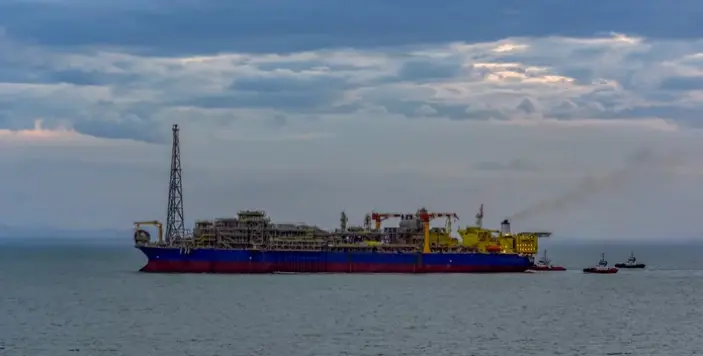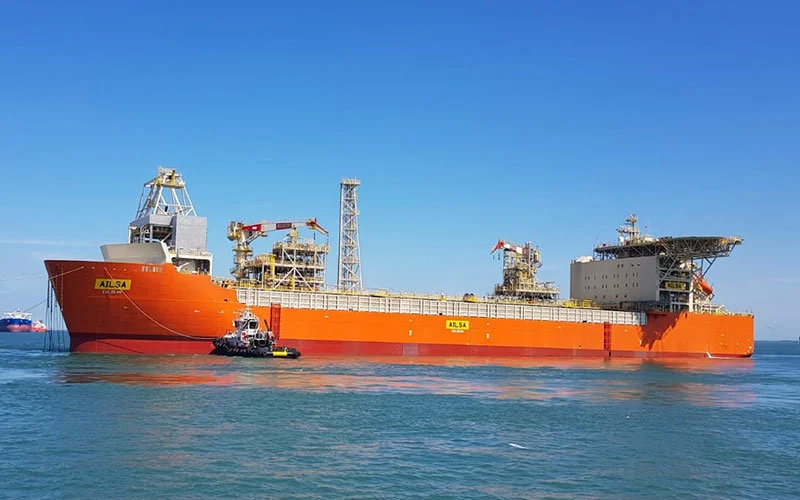Table of Contents
The difference between FPSO (Floating Production Storage and Offloading) and FSO (Floating Storage and Offloading) is, FPSO process, store and offload oil, while FSO only store and offload it. FPSO vs FSO are two different concepts you need to understand while exploring the domain of offshore oil and gas production.
FPSO and FSO share similarities in their operational concepts; they serve distinct functions and cater to different needs within the industry. FPSOs are frequently favored when exporting oil from deep oceans without local pipeline infrastructure. FSOs are only used to store and transport oil without processing capabilities.
It’s essential to understand the difference between FPSO and FSO as the demand for FPSO projects in the oil and gas industry is rising. Let’s explore the key differences and applications of FSO vs FPSO in offshore oil and gas production.
What is an FPSO?

FPSO means a large offshore vessel that is based on the production and storage of hydrocarbons in varying water depths. The FPSO system integrates oil and gas separation, oily wastewater treatment, power generation, and heat supply. It also includes crude oil product storage and transportation facilities. It also acts as a hub for workers and production command systems ensuring efficiency in oil production.
The FPSO allows oil corporations to produce oil in remote locations in the deeper sea by offering storage space for treated crude oil. Also, it acts as an offloading mechanism for shuttle tanker transportation to refineries. This eliminates the requirement for a pipeline for oil delivery to shore, which is highlighted as the cost-effectiveness of an FPSO. SBM Offshore, MODEC, BW Offshore, ExxonMobil, Shell, and CNOOC Ltd. are some of the top global FPSO manufacturers.
Structure of the FPSO

FPSOs have been subjected to further additions since Shell built the world’s first FPSO in 1977. These floating units have complex structures designed to withstand harsh offshore environments while accommodating various production and storage facilities. The structure of an FPSO typically comprises several key components:
Hull
- The hull of an FPSO serves as the main structural foundation, providing buoyancy and stability to the vessel.
- FPSO hulls are often converted from existing tanker vessels or purpose-built to accommodate specific project requirements.
- They are designed to withstand wave action, wind forces, and other environmental loads encountered in offshore locations.
Find FPSO Projects and Tender Leads around the GlobeClaim Your Free Leads!
Topsides Facilities
- Atop the hull, FPSOs feature topside facilities that house the processing, production, and accommodation modules.
- These facilities include equipment for hydrocarbon processing, separation, and treatment, as well as utilities such as power generation, regasification, and water treatment systems.
- FPSO topsides are modular in design, with flexible pipelines that accommodate various production requirements.
Mooring System
- FPSOs are equipped with mooring systems to anchor the vessel in place and maintain position over the offshore field.
- Mooring systems typically consist of anchor lines, chains, and risers connected to the FPSO hull and anchored to the seabed.
- Various mooring configurations, such as spread mooring or turret mooring systems, may be employed depending on the water depth and environmental conditions.
Offloading Systems
- FPSOs feature offloading systems for transferring processed hydrocarbons to shuttle tankers or other vessels for transportation to shore.
- Offloading systems may include tandem mooring arrangements, where tankers are connected to the FPSO via mooring lines, or offloading arms for direct vessel-to-vessel transfers.
Functions of an FPSO
Here we explore the significant functions of an FPSO:
- Production: Through the use of a system of risers and pipes, FPSOs can directly extract gas and oil from subsea wells.
- Processing: The FPSO separates the extracted gas and oil into a variety of components, including water, contaminants, natural gas, and crude oil.
- Storage: After being processed, the crude oil is kept in the enormous storage tanks of the FPSO until there is enough for unloading.
- Offloading: The procedure of moving the stored oil onto shuttle tankers for delivery to refineries or export terminals is known as offloading.
Read: Top 4 FPSO Companies in India [2024]
What is an FSO?

FSO vessel is primarily an oil tanker with a floating storage unit. It is exclusively used for the storage and offloading of natural gas or crude oil, and it does not have the production equipment seen on FPSOs. FSOs are frequently used as stand-alone units or in coordination with permanent offshore platforms to provide temporary storage.
Structure of FSOs
The structures of FSOs are designed to provide storage and transportation facilities for the hydrocarbons separated in offshore operations. Let’s get familiarized with the structures of FSOs:
Hull
- Similar to FPSOs, the hull of an FSO provides buoyancy and stability to the vessel.
- FSO hulls may be purpose-built or converted from existing tanker vessels, depending on project requirements.
- They are designed to withstand environmental loads and ensure safe operation in offshore locations.
Storage Tanks
- The onboard storage tanks of an FSO provide its main feature, which is storage capacity.
- These tanks are designed to store crude oil or natural gas safely and securely, with provisions for monitoring and maintenance.
- Storage tanks may be located within the hull or integrated into topside modules, depending on vessel design.
Find FPSO Projects and Tender
Leads around the Globe Claim Your Free Leads!
Mooring System
- Similar to FPSOs, FSOs are equipped with mooring systems to anchor the vessel in place.
- Mooring systems for FSOs typically consist of anchor lines, chains, and risers connected to the vessel and anchored to the seabed.
- Various mooring configurations may be employed based on water depth and environmental conditions.
Offloading Systems
- FSOs feature offloading systems for transferring stored hydrocarbons to shuttle tankers or other vessels for transportation to shore.
- Offloading systems may include hoses or offloading arms for flexible or direct vessel-to-vessel transfers.
- These sections provide an overview of the structural components and design considerations for both FPSOs and FSOs, highlighting their similarities and differences in construction and operation.
Functions of the FSO
FSOs are floating storage units that temporarily store crude oil or natural gas, providing a secure environment. They also facilitate the offloading of stored hydrocarbons onto shuttle tankers or other vessels for transportation to refineries or distribution centers. Let’s take a look into the functions of a FSO:
Storage: Before being prepared for offloading, processed crude oil that has been brought from onshore or offshore platforms is kept in the FSO's tanks.
Offloading: FSOs use shuttle tankers, just like FPSOs, to move the oil they have stored to refineries or export ports.
Key differences between FPSO and FSO
Even though these two offshore vessels possess similarities in their structure, there are key differences between their functions. This includes the production facilities, offloading mechanism, ability to conduct field development, and mobility of the vessels. Let’s have a deep dive into the significant difference between FPSO vs FSO.
Production Facilities
The most significant distinction between FPSOs and FSOs lies in their production capabilities. FPSOs are equipped with onboard processing facilities, allowing them to process raw hydrocarbons extracted from subsea wells. In contrast, FSOs lack such processing capabilities and are used solely for the storage of already processed oil or gas.
Offloading Mechanism
FPSOs are designed with offloading systems capable of transferring processed oil or gas directly to tankers for transportation to refineries or markets. These offloading systems may include tandem mooring systems or dynamic positioning (DP) systems for vessel-to-vessel transfers. FSOs, on the other hand, typically rely on shuttle tankers or pipelines to transfer stored hydrocarbons to shore or other vessels.
Field Development
FPSOs are often employed in offshore fields with complex geographies or where the reservoirs are located in deep water depths. Their ability to process hydrocarbons at the point of extraction makes them suitable for remote or challenging environments. FSOs, meanwhile, are commonly used to connect with fixed platforms or in fields with existing infrastructure.
Flexibility and mobility
Due to their production capabilities, FPSOs offer greater flexibility in field development and production optimization. They can be moved to different locations as reservoirs deplete or new fields are discovered. FSOs, being primarily storage units, are less mobile and are typically stationed at a fixed location for the duration of their service.
Read: Global FPSO market report
Applications of FPSO and FSO
Explore the diverse range of applications where FPSO and FSO units play pivotal roles in offshore oil and gas production:
FPSO Applications
- Deepwater Fields: FPSOs excel in deepwater environments where fixed infrastructure is impractical.
- Remote Locations: They are ideal for offshore fields located far from shore or existing infrastructure.
- Early Production Systems (EPS): FPSOs can be deployed as EPS to commence production while permanent facilities are being constructed.
FSO Applications
- Augmenting Storage Capacity: FSOs are used to increase storage capacity in fields with existing infrastructure.
- Temporary Storage: They provide temporary storage solutions during the maintenance or repair of onshore facilities.
- Emergency Response: FSOs can serve as emergency storage units during oil spill response operations.
To get insights about UK FPSO market follow : https://www.blackridgeresearch.com/reports/united-kingdom-uk-floating-production-storage-and-offloading-fpso-market
To summarize
The FPSO and FSO are different from each other according to their functions, structure, and application. FPSOs are equipped with floating production storage facilities and are suitable for deepwater fields and remote locations, offering flexibility and mobility in field development. On the other hand, FSOs primarily focus on storage and offloading functions, serving as temporary storage units or emergency response solutions. For facilitating offshore oil and gas production, the applications of these floating vessels vary. FPSO enables early floating production systems that become cost-effective, and FSO is used for its storage facilities.
Looking for more than generic information on FPSO vessels around the Globe?
Subscribe to our Global FPSO & FSO (Oil & Gas) Projects and Tender Database to access reliable and high-quality insights on upcoming, in-progress, and completed floating offshore plant projects across the world or in your desired location.
Our user-friendly platform provides essential details, timely updates, key stakeholder contact information, and business opportunities tailored for engineering companies, industry professionals, investors, and government agencies.
Start a free demo to take your business to the next level!

Leave a Comment
We love hearing from our readers and value your feedback. If you have any questions or comments about our content, feel free to leave a comment below.
We read every comment and do our best to respond to them all.